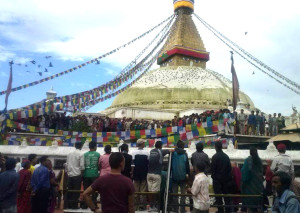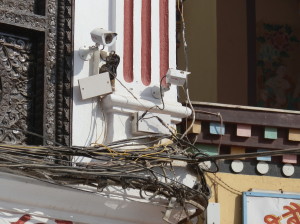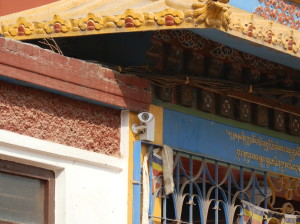- A 38-year old monk called Karma Ngedon Gyatso died after setting himself on fire at the Boudha stupa in Kathmandu, Nepal, yesterday (August 6). Karma Ngedon Gyatso, who was unable to walk due to a severe disability, had arrived in exile from Tibet in October, 2011. Tibetans who knew him describe him as deeply religious. It is the second fatal self-immolation by a Tibetan monk in Kathmandu this year after Drupchen Tsering set himself on fire in February, also at the Boudha stupa.
- Graphic images show onlookers gazing down on the man’s blackened body curled up in an area inside the stupa, an important pilgrimage circuit, where Tibetans go to prostrate and make offerings. (WARNING GRAPHIC: View images »)

The location of the Tibetan self-immolation at the Boudha stupa in Kathmandu.
An Australian eyewitness wrote in a note to the Australia Tibet Council:
“From the upper reaches of the stupa you can look down at Tibetan Buddhists praying, prostrating, and chanting within the stupa grounds. They are not visible to the thousands of people doing kora [circumambulation of the stupa] a few meters away on the outside. At around 7:30 am, while passing a secluded area – no one else around – I looked down to the left. Hidden from view was a monk sitting cross-legged. His lap was on fire and my first thought was, “Oh my god, he’s accidentally set himself on fire with a butter lamp.” Then he poured a bottle of fluid (kerosene/gasoline) over his head and went up in flames in front of me. He was silent as far as I could hear. I began to shout for help. He keeled over in a crouched position, with a contorted face but he didn’t cry out or scream at all. I kept shouting for help.” (Facebook, Letter from an Australian who witnessed today’s self-immolation).
The Himalayan Times in Nepal cited a Nepalese witness called Deepak Shrestha, who was whitewashing a part of the stupa in the morning, saying that he rushed to the scene when he saw flames rising from the area and attempted to extinguish the fire (Himalayan Times, August 6, 2013).
The Australian eyewitness said that he thought police arrived on the scene after around five to ten minutes, and then saw a group of men carrying the body to the main road in Boudhanath. According to the Himalayan Times, police recovered two plastic bottles with dregs of kerosene, a matchbox and a half-burnt bag containing a document with ‘Karma Ngedon Gyatso of Damshung Dzong, Lhasa’ written on it.
Tibetan exile sources confirmed that Karma Ngedon Gyatso was from Damshung (Chinese: Dangxiong) in Lhasa Municipality, the Tibet Autonomous Region. He used his hands for mobility, dragging his paralysed legs behind him. His disability may have been the result of polio in childhood, sources in Nepal said. Although the Hindustan Times cited unnamed police officials alleging that he was ‘mentally unstable’ – a charge that has been levelled by the Chinese authorities at some of the Tibetans in Tibet who set themselves on fire – individuals who knew Karma Ngedon Gyatso told ICT that this was not the case. (Hindustan Times, Tibetan refugee self-immolates, dies in Kathmandu).
One Tibetan who knew Karma Ngedon Gyatso said that he was intensely religious, and was often seen doing the kora (circumambulation) despite his disability. While he belonged to a monastery in Tibet, he had not joined a monastery in Kathmandu, according to Tibetans who knew him.
Nepalese police took the monk’s body to Tribhuwan University hospital where he was declared dead at around 8.30 am. There was soon a strong police presence in the stupa area, with some police carrying fire extinguishers. Some Tibetans have been questioned since the incident.
The self-immolation is the second in Kathmandu this year; Tibetan monk Drupchen Tsering (Druptse) set fire to himself and died in Kathmandu on February 13 (ICT report, Dismay over hasty secret cremation of Tibetan monk who self-immolated in Nepal). On November 10, 2011, a monk identified as Bhutuk wrapped a Tibetan flag around himself at the stupa, doused himself in kerosene while shouting slogans calling for a free Tibet and set himself alight. Pilgrims and locals managed to extinguish the flames and Bhutuk survived. (ICT, Self-immolations by Tibetans (in exile)).
Tibetans live a precarious existence in Nepal, particularly in Kathmandu, where the Nepalese authorities are under intense pressure from the Chinese government to curb Tibetan activities. After Bhutuk’s self-immolation, he went into hiding in order to evade arrest. Bhutuk is originally from Kardze (Chinese: Ganzi) in Sichuan Province, the Tibetan region of Kham, and had he been detained in Nepal there were fears that he may have been deported back into Chinese custody.
New closed circuit televisions in Boudha intensify surveillance
 Security camera in the Boudha stupa area of Kathmandu.  A video camera for closed-circuit TV is visible on this wall in Kathmandu, Nepal. |
Karma Ngedon Gyatso chose a specific location at Boudhanath to self-immolate, perhaps indicating his determination to carry out the act without being prevented, as it is not visible from the main pilgrimage route around the stupa. According to reports from Boudha, the area may also be out of range of the closed circuit television screens that have been placed in the area.
Video cameras were installed in the Boudha area in September 2012, situated around the stupa and on the main roads nearby. In the weeks following their installation, local people were told they were for ‘tourist safety’ and to combat tourists not paying to enter the Boudha stupa area. But no particular vigilance around collecting tourist fees was observed following their installation, and in recent weeks, the Nepalese press have run reports linking the cameras to specific concern by the authorities about ‘anti-China’ activities by Tibetans.
The Himalayan News Service reported that “Alarmed by alleged anti-China activities in Bouddha” an ‘Integrated Security System’ was inaugurated at the end of July, involving 35 state-of-the-art surveillance cameras installed in two strategic locations, including 16 cameras around the Boudhanath Stupa, “which officials claimed is hotspot of Free Tibet movement and anti-China activities”. (Himalayan News Service, Bouddha under surveillance for anti-China acts – July 29, 2013).
A researcher who was in Kathmandu following their installation said: “Anecdotally we heard the cameras are using facial recognition software to support surveillance by other means, and they add to the feeling of being watched that was already present among Tibetans in Nepal.”
Although it is not known whether the new surveillance cameras were directly funded by the Chinese authorities, the Nepalese press reported in July that: “China had provided communications sets and closed circuit televisions worth around 360 million Nepalese Rupees ($3 million) to Nepalese Police a month ago” (Karobar National Economic Daily, Kathmandu, Donors compete to invest in security agencies – July 26, 2013). According to the same report this was part of a commitment made by the then Chinese Premier Wen Jiabao in February 2012, of 10 million yuan ($1.6 million) to Nepalese police and 4 million yuan ($653,680) to the Armed Police Force in Nepal under a ‘security strengthening’ program.
The situation for the 20,000 or so long-staying Tibetans in Nepal – many of whom have lived as refugees in Nepal since the early 1960s – has worsened dramatically since 2008. During the same period, the dangers for Tibetans escaping Tibet via Nepal have intensified as China seeks to close this essential gateway into exile. Beyond the economic and political factors that impact the lives of all in post-conflict Nepal, Tibetans experience other difficulties brought about by substantial and increasing Chinese influence on the Nepal state. For further details on the situation of Tibetans in Nepal, see ICT report ‘Dangerous Crossing.’

